New Guinea singing dog
The New Guinea singing dog or New Guinea Highland dog[1] (scientific name: Canis hallstromi,[1] taxonomic classification: Canis familiaris[2][3][4][5] or Canis lupus dingo[6]) is a dog native to the New Guinea Highlands of the island of New Guinea. Its taxonomic status is debated. It is closely related to the Australian dingo.
| New Guinea singing dog | |
|---|---|
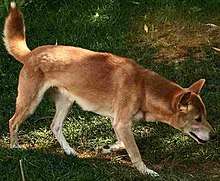 | |
| Other names | New Guinea Highland dog, Hallstrom's dog |
| Origin | New Guinea |
| Breed status | Not recognised as a breed by any major kennel club. |
| Notes | Breed recognized ARBA refer Breed details |
| Dog (domestic dog) | |
The dog is noted for its unique vocalization. Little is known about New Guinea singing dogs in the wild, and there are only two photographs of possible wild sightings. In 1989, the Australian mammalogist Tim Flannery took a photo of a black-and-tan dog in Telefomin District. He wrote that these dogs live with native people in the mountains, and that there were feral populations living in the alpine and sub-alpine grasslands of the Star Mountains and the Wharton Range. The photo was published in his book Mammals of New Guinea.[5] In 2012, Australian wilderness adventure guide Tom Hewett took a photo of a tawny, thick-coated dog in the Puncak Mandala region of West Papua, Indonesia.[7]
In 2016, a literature review found that there is no definitive evidence that the founding members of captive populations of New Guinea singing dogs were wild-living animals; they were raised as members of village populations of domestic dogs.[8]
Taxonomy
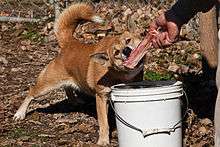
In 1999, a study of mitochondrial DNA indicated that the domestic dog may have originated from multiple grey wolf populations, with the dingo and New Guinea singing dog "breeds" having developed at a time when human populations were more isolated from each other.[9] In the third edition of Mammal Species of the World published in 2005, the mammalogist W. Christopher Wozencraft listed under the wolf Canis lupus its wild subspecies, and proposed two additional subspecies: "familiaris Linnaeus, 1758 [domestic dog]" and "dingo Meyer, 1793 [domestic dog]". Wozencraft included hallstromi – the New Guinea singing dog – as a taxonomic synonym for the dingo. Wozencraft referred to the mDNA study as one of the guides in forming his decision.[6] The inclusion of familiaris and dingo under a "domestic dog" clade has been noted by other mammalogists.[4] This classification by Wozencraft is debated among zoologists.[10]
In 2019, a workshop hosted by the IUCN/SSC Canid Specialist Group considered the New Guinea Singing Dog and the Dingo to be feral dogs Canis familiaris, and therefore should not be assessed for the IUCN Red List.[2]
Taxonomic history
During the Torres expedition to the south coast of New Guinea and the Torres Strait in 1606, small dogs were recorded by Captain Don Diego de Prado Y Tovar:
We found small dumb dogs that neither bark nor howl, and do not cry out even if beaten with sticks[11]
On 26 October 1897, the Lieutenant-Governor of British New Guinea, Sir William MacGregor, was on Mount Scratchley, Central Province, Papua New Guinea. At an elevation of 7,000 ft (2,100 m) he recorded that "animals are rare", but listed "wild dog". MacGregor obtained the first specimen and later Charles Walter De Vis wrote a description of it in 1911.[12][1] De Vis summarised from his description that:
... it is not a "truly a wild dog"; in other words that there was a time when its forebears were not wild. ...But if we decide that this dog is merely feral, of a domestic breed run wild, as dogs are apt to do, how are we to account for its habitat on Mount Scratchley?[12]
In 1954, collectors for the Australian Museum observed these dogs around villages situated at 8,000 ft (2,400 m) on Mount Giluwe in the Southern Highlands Province.[1] In 1956, Albert Speer and J. P. Sinclair obtained a pair of singing dogs in the Lavani Valley that was situated in Southern Highlands Province.[13] The two dogs had been obtained from natives.[1] The dogs were sent to Sir Edward Hallstrom who had set up a native animal study center in Nondugi, and from there to the Taronga Zoo in Sydney, Australia.[13] In 1957, Ellis Troughton examined the two singing dog specimens from the Taronga Zoo and classified them as a distinct species Canis hallstromi in honour of Hallstrom.[14]
Troughton described the type specimen as follows:
Specimens. — Male holotype, female allotype, in possession of Sir Edward Hallstrom at Taronga Zoological Park, Sydney, for eventual lodgment in the collection of the Australian Museum.
General characters:
Muzzle or rostral region short and narrow in contrast with the remarkable facial or bi-zygomatic width, imparting the strikingly vulpine or fox-like appearance. This comparison is sustained in the narrow body and very short bushy tail which measures little more than one third of the combined head-and-body length, with the width of the brush a fraction under 4 in (10 cm). The fleshy, softly furred, triangulate ears remain erect, though rounded and curved forward in conch-like fashion.
Colour (Ridgway[lower-alpha 1]) of the head a clear tawny brown; the back a darker russet-brown owing to the admixture of blackish-brown hairs, the darker hairs enclosing a yellowish "saddlemark" somewhat more conspicuous in the female. Outer shoulders and hips clear ochraceous-tawny; tail about tawny-olive brindled above with blackish-brown, tip white; four paws whitish. Underparts a light buffy, a dark mark across the jaw separating the light chin-spot from the pale undersurface.
Dimensions of Holotype:
Head and body approximately 650 mm (26 in); tail exactly 245 mm (9.6 in), less brush; heel to longest toe, less nail, 145 mm (5.7 in); dew-claw from base to ground, 25 mm (0.98 in); ear, length from outer base to tip 75 mm (3.0 in), midwidth 40 mm (1.6 in); longest vibrissa 52 mm (2.0 in); length of head to extremity of sagittal crest 180 mm (7.1 in) (approx.) and bi-zygomatic width 100 mm (3.9 in); rear molar to incisor 90 mm (3.5 in); width across incisors 23 mm (0.91 in); height of upper canine 16 mm (0.63 in).[14]
Lineage
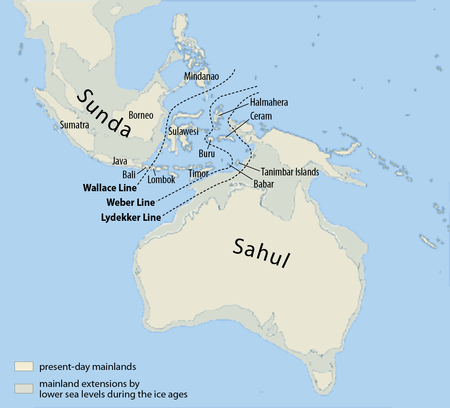
Whole genome sequencing indicates the domestic dog to be a genetically divergent subspecies of the gray wolf;[18] the dog is not a descendant of the extant gray wolf, but these are sister taxa which share a common ancestor from a ghost population of wolves that went extinct at the end of the Late Pleistocene,[19] and the dog and the dingo are not separate species.[18] The dingo and the Basenji are basal members of the domestic dog clade.[18][20][19] Mitochondrial genome sequences indicates that the dingo falls within the domestic dog clade,[21] and that the New Guinea singing dog is genetically closer to those dingoes that live in southeastern Australia than to those that live in the northwest.[16] The dingo and New Guinea singing dog lineage can be traced back through the Malay Archipelago to Asia.[22] Gene flow from the genetically divergent Tibetan wolf forms 2% of the dingo's genome,[18] which likely represents ancient admixture in eastern Eurasia.[19][23]
At the end of the Last glacial maximum and the associated rise in sea levels, Tasmania became separated from the Australian mainland 12,000 YBP,[15] and New Guinea 6,500–8,500 YBP[16][17] by the inundation of the Sahul Shelf.[24] Fossil remains in Australia date to approximately 3,500 YBP and no dingo remains have been uncovered in Tasmania; therefore, the dingo is estimated to have arrived in Australia at a time between 3,500-12,000 YBP. To reach Australia through the Malay Archipelago even at the lowest sea level of the Last Glacial Maximum, a journey of at least 50 km over open sea between ancient Sunda and Sahul was necessary, indicating that the dingo arrived by boat.[25]
In 2016, a literature review found that:
there is no convincing evidence that New Guinea wild-living dogs and some, or all, pre-colonization New Guinea village dogs were distinct forms. Further, there is no definitive evidence that either high altitude wild-living dogs were formerly isolated from other New Guinea canids or that the animals that were the founding members of captive populations of New Guinea Singing Dogs were wild-living animals or the progeny of wild-living animals rather than being born and raised as members of village populations of domestic dogs. We conclude that:
- (1) at the time of European colonization, wild dogs and most, if not all, village dogs of New Guinea comprised a single though heterogeneous gene pool
- (2) eventual resolution of the phylogenetic relationships of New Guinea wild dogs will apply equally to all or most of the earliest New Guinea village-based, domesticated, dogs; and
- (3) there remain places in New Guinea, such as Suabi and neighbouring communities, where the local village-based population of domestic dogs continues to be dominated by individuals whose genetic inheritance can be traced to pre-colonization canid forebears.[8]
Description
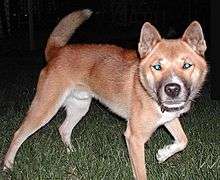
Australian mammalogist Tim Flannery in his book the Mammals of New Guinea describes the "New Guinea Wild Dog" as looking similar to the dingo, only smaller. Most of these dogs in New Guinea are domesticated with large numbers being kept by widows and bachelors, with hunters keeping at least two for assisting them with hunting. These dogs do not bark, and their chorused howling makes a haunting and extraordinary sound, which has led to their alternative name of "New Guinea Singing Dog". Flannery published in his book a photo of a black-and-tan dog in the Telefomin District. He wrote that these dogs live with native people in the mountains, and that there were feral populations living in the alpine and sub-alpine grasslands of the Star Mountains and the Wharton Range.[5]
Compared with other species in its genus, the New Guinea singing dog is described as relatively short-legged and broad-headed. These dogs have an average shoulder height of 31–46 cm (12–18 in) and weigh 9–14 kg (20–31 lb). They do not have rear dewclaws.[26]
The limbs and spine of the New Guinea singing dog are very flexible and they can spread their legs sideways to 90°, comparable to the Norwegian Lundehund. They can also rotate their front and hind paws more than domestic dogs, which enables them to climb trees with thick bark or branches that can be reached from the ground; however, their climbing skills do not reach the same level as those of the gray fox.[27]
The eyes, which are highly reflective, are triangular (or almond-shaped) and are angled upwards from the inner to outer corners with dark eye rims. Eye color ranges from dark amber to dark-brown. Their eyes exhibit a bright green glow when lights are shone on them in low light conditions. There are two features which researchers believe allow New Guinea singing dogs to see more clearly in low light.[27] One is that of their pupils, which open wider and allow in more light than in other dog varieties. The other is that they possess a higher concentration of cells in the tapetum.
New Guinea singing dogs have erect, pointed, fur-lined ears. As with other wild dogs, the ears 'perk', or lay forward, which is suspected to be an important survival feature for the species. The ears can be rotated like a directional receiver to pick up faint sounds. Their tails are bushy, long enough to reach the hock, free of kinks, and have a white tip.
Pups are born with a dark chocolate brown pelt with gold flecks and reddish tinges, which changes to light brown by the age of six weeks. Adult coloration occurs around four months of age. For adult dogs, the colors brown, black, and tan have been reported, all with white points. The sides of the neck and zonal stripes behind the scapula are golden. Black and very dark guard hair is generally lightly allocated over the hair of the spine, concentrating on the back of the ears and the surface of the tail over the white tip. The muzzle is always black on young dogs. Generally, all colors have white markings underneath the chin, on the paws, chest and tail tip. About one third also have white markings on the muzzle, face and neck. By 7 years of age, the black muzzle begins to turn gray.[26]
Behavior
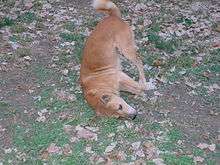
All sightings in the wild were of single dogs or pairs, therefore it can be inferred that wild New Guinea singing dogs do not form permanent packs.[26] Tim Flannery's short 1989 report on dogs in the mountains of Papua New Guinea described them as "extraordinarily shy" and "almost preternaturally canny".[28] According to Robert Bino (1996),[lower-alpha 2] these dogs only use their resting places under roots and ledges in New Guinea sporadically. Bino conjectured that these dogs are highly mobile and forage alone and concluded that they therefore might use several hiding places in their home range.[29]
During research observations, the examined dogs generally showed a lower threshold of behavior (e.g., scent rolling) than other domestic dogs, as well as an earlier developmental onset than other domestic dogs or grey wolves (e.g., hackle biting at two weeks compared to other domestic dogs/grey wolves at 6 weeks) and a quantitative difference (e.g., reduced expression of intraspecific affiliate behaviors). The dogs observed did not show the typical canid play bow; however, Imke Voth found this behavior during examinations in the 1980s.[30]
Several behaviors unique to New Guinea singing dogs have been noted:[26]
- Head toss
- This behavior, shown by every observed dog, is a prompt for attention, food or a sign of frustration, expressed in varying degrees depending on the level of arousal. In the complete expression, the head is swept to one side, nose rotated through a 90° arc to midline, then rapidly returned to the starting position. The entire sequence takes one to two seconds. The mildest expression is a slight flick of the head to the side and back. During this behavior, the characteristic contrasting black and white chin markings are displayed.
- Copulatory scream
- At the copulatory tie, the female emits a repetitive sequence of loud, high-pitched yelps lasting about three minutes. This scream has a strong arousal effect on most domestic dogs.
- Copulatory contractions
- About three minutes after the start of the tie, females begin a series of rhythmic abdominal contractions. During each contraction, the skin of the flanks and lumbar area is drawn forward. These contractions are accompanied by groans and occur regularly, several seconds apart (they may pause intermittently), continuing for the length of the tie.
Additionally, New Guinea singing dogs have an unusual form of auto-erotic stimulation, which includes a strong tendency to target the genitals for both playful and aggressive bites, a cheek-rub that may be a marking behavior and a tooth-gnashing threat.
During estrus, when potential partners are present, same-sex New Guinea singing dogs often fight to the point of severe injury. Furthermore, adults also display a high degree of aggression towards unfamiliar dogs, which would indicate that they are strongly territorial.[26] Their distinctive aggression could not be observed to that extent among Australian dingoes (who live without human contact).[31]
Researchers have noted rough play behavior by the mothers towards their pups, which often switched over to agonistic behavior as well as "handling". The mothers did not adequately react to the pups' shouts of pain but rather interpreted it as further "invitation" for "playing". The researchers stated that this behavior was noted in their subjects only and does not necessarily apply to all singing dogs.[31]
Vocalizations

New Guinea singing dogs are named for their distinctive and melodious howl, which is characterized by a sharp increase in pitch at the start and very high frequencies at the end.[32] According to observations made by Ortolani,[33] the howling of these dogs can be clearly differentiated from that of Australian dingoes, and differs significantly from that of grey wolves and coyotes.
An individual howl lasts an average of 3 seconds, but can last as long as 5 seconds. At the start, the frequency rises and stabilizes for the rest of the howling, but normally shows abrupt changes in frequency. Modulations can change quickly every 300–500 milliseconds or every second. Five to eight overtones can generally be distinguished in a spectrographic analysis of the howling.[26] Their howl reportedly has been compared to the song of a humpback whale.[34]
New Guinea singing dogs sometimes howl together, which is commonly referred to as chorus howling. During chorus howling, one dog starts and others join in shortly afterward. In most cases, chorus howling is well synchronized, and the howls of the group end nearly simultaneously. Spontaneous howling is most common during the morning and evening hours.[31] A trill, with a distinctly "bird-like" character, is emitted during high arousal. It is a high-frequency pulsed signal whose spectral appearance suggests a continuous source that is periodically interrupted, and might last as long as 800 milliseconds. Such a sound is not known for any other canid; however, a similar sound (with lower frequency) has been described for a dhole at the Moscow Zoo.[26] When they are kept with dogs that bark, New Guinea singing dogs may mimic the other dogs.[31]
Reproduction
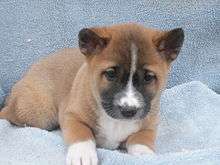
Like other dingo types, female New Guinea singing dogs come into heat once a year, rather than twice a year normally associated with domestic dog breeds. Their breeding season generally starts in August and ends during December. Gestation averages 63 days. In Tierpark Berlin, 80% of the litters were born in October and November and the gestation period was 58–64 days. The litter size was 1–6 pups.[35] Reports of 25 female singing dogs in captivity showed that when they did not conceive during their first annual estrus, about 65% have a second estrus cycle, sometimes even a third,[36] 8–16 weeks later.[26]
Males in captivity often participate in raising the pups, including the regurgitation of food. Female New Guinea singing dogs are protective of their young and will aggressively attack their male counterpart if they suspect he poses a danger to the pups. During the first breeding season following their birth, especially if there is a potential mate present, pups are often aggressively attacked by the same-sex parent.[26]
Diet
Reports from local sources in Papua New Guinea from the 1970s and the mid-1990s indicate that New Guinea singing dogs-like wild dogs found in New Guinea, whether they were pure New Guinea singing dogs or hybrids-fed on small to middle-sized marsupials, rodents, birds, and fruits. Robert Bino stated that their prey consisted of cuscuses, wallabies, dwarf cassowaries, and other birds.[36][26] New Guinea singing dogs in captivity do not require a specialized diet, but they seem to thrive on lean raw meat diets based on poultry, beef, elk, deer, or bison.[37]
Relationship with other predators
New Guinea singing dogs have been reported engaging in kleptoparasitic behavior towards Papuan eagles. In turn, the birds have been known to kill adult dogs.[38]
Status and distribution
Status in the wild
Since 1956, New Guinea singing dogs have been obtained or sighted in the wild chiefly in mountainous terrain around the central segment of the New Guinea Highlands, a major island-extensive east–west running mountain range formation, as the 1956 dogs obtained by Speer and Sinclair (see 'History and classification' section above) were in what's now typically spelled the Lavani Valley slightly to the East, the Star Mountains slightly to the West of center sited reports through 1976. Reports of the Kalam people capturing New Guinea singing dogs in the mid-1970s imply the human tribe's range just off center east on the northeastern mainland coast (see 'Relationship with humans' section below). A 2007 sighting in the Kaijende Highlands was east of the center. The 2012 sighting was near Puncak Mandala slightly to the west, all in the highlands around the range's spine.
The reported habitat of the New Guinea singing dog consists of mountains and swampy mountain regions of Papua New Guinea at an altitude of 2,500 to 4,700 meters. The main vegetation zones are the mixed forest, beech and mossy forest, sub-alpine coniferous forest and alpine grassland. Based on archaeological, ethnographic, and circumstantial evidence, it can be assumed that New Guinea singing dogs were once distributed over the whole of New Guinea and later restricted to the upper mountains.[26] Since there have been no verified sightings of these dogs in Papua New Guinea since the 1970s until an August 2012 photograph in the wild, these dogs are now apparently rare.[32][39]
There were reports of New Guinea singing dogs in the Star Mountains until 1976, and in the mid-1970s reports of capture and training, but not breeding by the Kalam people (see 'Relationship with humans' section below).
In his 1998 book Throwim Way Leg, Tim Flannery states that the dokfuma (which he describes as sub-alpine grassland with the ground being sodden moss, lichens and herbs growing atop a swamp) at 3,200 meters elevation had plenty of New Guinea singing dogs, which could usually be heard at the beginning and end of each day. When alone in his campsite one day, a group of canines came within several hundred meters of him. Flannery apparently did not have his camera along or ready, since he reported no pictures taken.
In 1996 Robert Bino undertook a field study of these dogs, but was not able to observe any wild New Guinea singing dogs and instead used signs, such as scats, paw prints, urine markings and prey remnants, to make conclusions about their behavior. No DNA sampling was conducted. There have been reports from local residents that wild dogs have been seen or heard in higher reaches of the mountains.[27]
In a 2007 report, a more recent sighting was the fleeting glimpse of a dog at Lake Tawa in the Kaijende Highlands. Local assistants assured the researchers that the dogs at Lake Tawa were wild-living dogs, since there were no villages near that location. It needs to be made clear, however, that "wild-living" does not necessarily mean that canines observed by natives are New Guinea singing dogs. It is possible that they are simply feral domestic dogs or New Guinea singing dog hybrids.[40]
On 24 August 2012, the second known photograph of a New Guinea singing dog in the wild was taken by Tom Hewitt, Director of Adventure Alternative Borneo, in the Jayawijaya Mountains or Star Mountains of Papua Province, Indonesia, Western New Guinea by a trek party returning from Puncak Mandala, at approximately 4,760 m high the highest peak in the Jayawijaya range and second highest freestanding mountain of Oceania, Australasia, New Guinea and Indonesia (though Hewitt himself seems to erroneously say this peak is in the Star Mountains, which are adjacent to the Jayawijaya range, and also casually calls the region 'West Papua' rather than Indonesia's Papua Province in the Western geopolitical 'half' of the New Guinea landmasses, while his identification of the peak is quite clear, including its estimated elevation which is distinctive among New Guinea's peaks). In a valley flanked by waterfalls on both sides among approximately 4 km (13,000 ft) high limestone peaks, replete with such flora and fauna as cycads, grasses and blooms of the highlands, cuscuses, possums, tree kangaroos, unidentified ground-nesting birds in swamp grass, and a bird-of-paradise species heard but not seen, Hewitt relates that his veteran trek guide called out "dog" four times and pointed to fetch Hewitt and his trek client from their explorations behind large boulders and have them realize that ahead and above the guide and camp cook on a rocky outcrop was a dog, in Hewitt's words "not scared, but...genuinely curious...as we were of it, and it certainly felt like a rare meeting for both sides. The guides and cook were also surprised.” While the guide had at first approached "quite close", the dog retreated as the party came toward it, though it stayed on the hillside while being photographed for a mutual observation session of about 15 minutes. Hewitt only became fully aware of the importance of his party's sighting and photograph of this dog when he contacted Tom Wendt, New Guinea Singing Dog International (NGSDI)'s founder upon returning home, then regretting that he did not videorecord the encounter. Hewitt and Wendt observe that West Papuan locals report that sightings are rare, and that New Guinea singing dogs have not been domesticated by current human inhabitants of their area.[39][41]
In 2016, the New Guinea Highland Wild Dog Foundation announced to the media that it and the University of Papua had located and photographed a group of 15 of what it referred to as "highland wild dogs".[42] DNA analysis of scats indicate that these dogs have a genetic relationship with other oceanic dogs, including the dingo and the New Guinea singing dog.[43]
Captive status and distribution
In 2016, a literature review found that "there is no definitive evidence that...the founding members of captive populations of New Guinea Singing Dogs were wild-living animals or the progeny of wild-living animals rather than being born and raised as members of village populations of domestic dogs."[8]
Global zoo list
According to the New Guinea Singing Dog Conservation Society as of 2015, the complete list of zoos around the world where captive New Guinea singing dogs are kept is short relative to most zoo species, highlighting their varietal endangered condition after suspected extinction in the wild and the paucity of the zoo gene pool.
| Name | City/town | State/province/county | Country |
|---|---|---|---|
| Cleveland Metroparks Zoo | Cleveland | Ohio | United States |
| Tiger World | Rockwell | North Carolina | United States |
| Columbian Park Zoo | Lafayette | Indiana | United States |
| Conservators Center | Burlington | North Carolina | United States |
| Exmoor Zoo | Exmoor | North Devon | United Kingdom |
| Gentleshaw Wildlife Centre | Stafford | Staffordshire | United Kingdom |
| Gulf Breeze Zoo | Gulf Breeze | Florida | United States |
| Idaho Falls Zoo at Tautphaus Park | Idaho Falls | Idaho | United States |
| Kansas City Zoo | Kansas City | Missouri | United States |
| Living Desert Zoo | Palm Desert | California | United States |
| Miami Metrozoo | Miami | Florida | United States |
| Miller Park Zoo | Bloomington | Illinois | United States |
| Nashville Zoo at Grassmere | Nashville | Tennessee | United States |
| Palm Beach Zoo at Dreher Park | West Palm Beach | Florida | United States |
| San Diego Wild Animal Park | Escondido | California | United States |
| San Diego Zoo | San Diego | California | United States |
| Tampa's Lowry Park Zoo | Tampa | Florida | United States |
| Tierpark Neumünster | Neumünster | Schleswig-Holstein | Germany |
| Toronto Zoo | Toronto | Ontario | Canada |
| Wild Animal Safari | Pine Mountain | Georgia | United States |
| Wild Spirit Wolf Sanctuary | Candy Kitchen | New Mexico | United States |
| Wildlife World Zoo | Litchfield Park | Arizona | United States |
| Wizard of Paws Wildlife Education Inc. | Indianapolis | Indiana | United States |
| Zoo Zlín | Zlín | Zlín | Czech Republic |
| Zoonimal Wild Encounters | Geilenkirchen | North Rhine-Westphalia | Germany |
Relationship with humans
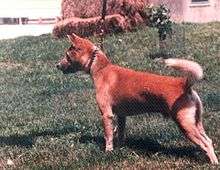
The onset of European culture's domestic dogs spelled the beginning of the end for pure New Guinea singing dogs in the lowlands. "Singing Dogs are very gentle and friendly with people, though inclined to be a bit shy with strangers at first," wrote New York owner Phillip Persky. "They are not at all aggressive with people" Sharon McKenzie said. "They are notorious escape artists," Mr. Persky reported, "and can climb and jump with cat-like agility, so enclosures have to be secure." "They are great diggers and can climb fences as easily as a squirrel."[13]
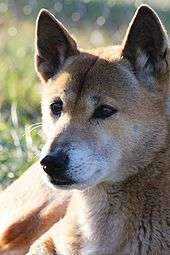
According to reports from the late 1950s and mid-1970s, wild dogs believed to be New Guinea singing dogs were shy and avoided contact with humans. It was reported in the mid-1970s that the Kalam in the highlands of Papua caught young New Guinea singing dogs and raised them as hunting aids, but did not breed them. Some of these dogs probably stayed with the Kalam and reproduced. The Eipo tribe kept and bred wild dogs as playmates for their children. Although the majority of the highland tribes never used village dogs as a food source, it is known that even today they attempt to catch, kill and eat wild dogs. Dog-findings in archaeological sites of New Guinea are rare, mostly consisting of teeth (used as ornaments) and trophy-skulls. One grave has been discovered. The earliest New Guinea singing dog remains was a tooth found in the lowlands. It was estimated to be about 5,500 years old. Findings from the highlands were thought to be of similar age, on a stratigraphical basis, but as of 2001 had not been dated. Since the beginning of the 20th century, the inhabitants of the highlands started to keep chickens, and New Guinea singing dogs had a penchant for poultry. To add to the problem, natives kept other domestic dogs. The crossbred dogs were generally larger in size, as well as less of a challenge to train, so they tended to be of more value than New Guinea singing dogs. One might conclude that the relationship between the contemporary New Guineans and their dogs will give information about how they treated the New Guinea singing dogs, but modern "village dogs" are not genetically representative of pure New Guinea singing dogs.[36][26][27]
Conservation and preservation
.jpg)
In the past, the New Guinea singing dog was considered "unworthy" of scientific study, as it was regarded as an insignificant variety of feral domestic dog. However, due to its potential value as a resource for the determination of the process of canid evolution and domestication, particularly in relation to the dingo, as well as several of its unique genetic, behavioral, ecological, reproductive and morphological characteristics, limited research has been undertaken.[26] The New Guinea Department of Environment and Conservation has announced protection measures.[32]
Hybridization is one of the most serious threats facing the New Guinea singing dog. New Guinea singing dogs are handicapped, as are many canids such as the Australian dingo, by their susceptibility to being bred by canines other than those of their own kind. This vulnerability has, and is still, causing a "watering down" of dingo genes needed to maintain purity.
There are three organizations that exist for the sole purpose of conserving and preserving New Guinea singing dogs. They are the New Guinea Singing Dog Conservation Society, founded in 1997,[44] New Guinea Singing Dog International, a preservation, captive breed, adoption and pet education group,[45] and Wizard of Paws Wildlife Education Inc.[46] All of these organizations are based in the United States.
Footnotes
- "Ridgeway" refers to Robert Ridgway's colour nomenclature. See The color books in Robert Ridgway.
- Robert Bino is a student from the University of Papua New Guinea.[29]
References
- The early history and relationships of the New Guinea Highland dog (Canis hallstromi) by Troughton, E. (1971). Proceedings of the Linnean Society of New South Wales 96, 93-98.
- Alvares, Francisco; Bogdanowicz, Wieslaw; Campbell, Liz A.D.; Godinho, Rachel; Hatlauf, Jennifer; Jhala, Yadvendradev V.; Kitchener, Andrew C.; Koepfli, Klaus-Peter; Krofel, Miha; Moehlman, Patricia D.; Senn, Helen; Sillero-Zubiri, Claudio; Viranta, Suvi; Werhahn, Geraldine (2019). "Old World Canis spp. with taxonomic ambiguity: Workshop conclusions and recommendations. CIBIO. Vairão, Portugal, 28th - 30th May 2019" (PDF). IUCN/SSC Canid Specialist Group. Retrieved 6 March 2020.
- Jackson, Stephen; Groves, Colin (2015). Taxonomy of Australian Mammals. CSIRO Publishing, Clayton, Victoria, Australia. pp. 287–290. ISBN 9781486300136.
- Jackson, Stephen M.; Groves, Colin P.; Fleming, Peter J.S.; Aplin, KEN P.; Eldridge, Mark D.B.; Gonzalez, Antonio; Helgen, Kristofer M. (2017). "The Wayward Dog: Is the Australian native dog or Dingo a distinct species?". Zootaxa. 4317 (2): 201. doi:10.11646/zootaxa.4317.2.1.
- Flannery, Timothy (1990). Mammals of New Guinea - The Australian Museum. Robert Brown & Associates, Carina, Qld., Australia. pp. 32–33. ISBN 1862730296.
- Wozencraft, W.C. (2005). "Order Carnivora". In Wilson, D.E.; Reeder, D.M (eds.). Mammal Species of the World: A Taxonomic and Geographic Reference (3rd ed.). Johns Hopkins University Press. pp. 575–577. ISBN 978-0-8018-8221-0. OCLC 62265494.
- Dell-Amore, Christine (2012). "Rare Singing Dog Photographed in New Guinea?". National Geographic. National Geographic Society.
- Dwyer, Peter D.; Minnegal, Monica (2016). "Wild dogs and village dogs in New Guinea: Were they different?". Australian Mammalogy. 38: 1. doi:10.1071/AM15011. hdl:11343/59567.
- Wayne, R. & Ostrander, Elaine A. (1999). "Origin, genetic diversity, and genome structure of the domestic dog". BioEssays. 21 (3): 247–57. doi:10.1002/(SICI)1521-1878(199903)21:3<247::AID-BIES9>3.0.CO;2-Z. PMID 10333734.CS1 maint: uses authors parameter (link)
- Smith 2015, pp. xi–24 Chapter 1 - Bradley Smith
- Stevens, Henry N; Barwick, G.F., eds. (1930). "Ch.4 - Relación de don Diego de Prado". New Light on the Discovery of Australia as Revealed by the Journal of Captain Don Diego de Prado Y Tovar. The Hakluyt Society. p. 141.
- De Vis CW, 1911. A wild dog from British New Guinea. Annals of the Queensland Museum 10:19-20.
- Flamholtz, Cathy J. (1991). A Celebration of Rare Breeds Vol.II. Centreville, AL, U.S.: OTR Publications. pp. 147–151. ISBN 978-0-940269-06-4.
- Troughton, E. (1957). "A new native dog from the Papuan Highlands, Proceedings of the Royal Zoological Society of New South Wales 1955–1956". 76th 1955-56. The Society.: 93–94. Cite journal requires
|journal=(help) - Ryan, Lyndall (2012). Tasmanian Aborigines. Allen & Unwin, Sydney. pp. 3–6. ISBN 9781742370682.
- Cairns, Kylie M.; Wilton, Alan N. (2016). "New insights on the history of canids in Oceania based on mitochondrial and nuclear data". Genetica. 144 (5): 553–565. doi:10.1007/s10709-016-9924-z. PMID 27640201.
- Bourke, R. Michael, ed. (2009). Food and Agriculture in New Guinea. Australian National University E. Press. ISBN 9781921536601.
- Fan, Zhenxin; Silva, Pedro; Gronau, Ilan; Wang, Shuoguo; Armero, Aitor Serres; Schweizer, Rena M.; Ramirez, Oscar; Pollinger, John; Galaverni, Marco; Ortega Del-Vecchyo, Diego; Du, Lianming; Zhang, Wenping; Zhang, Zhihe; Xing, Jinchuan; Vilà, Carles; Marques-Bonet, Tomas; Godinho, Raquel; Yue, Bisong; Wayne, Robert K. (2016). "Worldwide patterns of genomic variation and admixture in gray wolves". Genome Research. 26 (2): 163–73. doi:10.1101/gr.197517.115. PMC 4728369. PMID 26680994.
- Freedman, Adam H.; Gronau, Ilan; Schweizer, Rena M.; Ortega-Del Vecchyo, Diego; Han, Eunjung; Silva, Pedro M.; Galaverni, Marco; Fan, Zhenxin; Marx, Peter; Lorente-Galdos, Belen; Beale, Holly; Ramirez, Oscar; Hormozdiari, Farhad; Alkan, Can; Vilà, Carles; Squire, Kevin; Geffen, Eli; Kusak, Josip; Boyko, Adam R.; Parker, Heidi G.; Lee, Clarence; Tadigotla, Vasisht; Siepel, Adam; Bustamante, Carlos D.; Harkins, Timothy T.; Nelson, Stanley F.; Ostrander, Elaine A.; Marques-Bonet, Tomas; Wayne, Robert K.; et al. (2014). "Genome Sequencing Highlights the Dynamic Early History of Dogs". PLoS Genetics. 10 (1): e1004016. doi:10.1371/journal.pgen.1004016. PMC 3894170. PMID 24453982.
- Koepfli, K.-P.; Pollinger, J.; Godinho, R.; Robinson, J.; Lea, A.; Hendricks, S.; Schweizer, R. M.; Thalmann, O.; Silva, P.; Fan, Z.; Yurchenko, A. A.; Dobrynin, P.; Makunin, A.; Cahill, J. A.; Shapiro, B.; Álvares, F.; Brito, J. C.; Geffen, E.; Leonard, J. A.; Helgen, K. M.; Johnson, W. E.; O’Brien, S. J.; Van Valkenburgh, B.; Wayne, R. K. (17 August 2015). "Genome-wide Evidence Reveals that African and Eurasian Golden Jackals Are Distinct Species". Current Biology. 25 (16): 2158–65. doi:10.1016/j.cub.2015.06.060. PMID 26234211. Archived from the original on 7 November 2015. Retrieved 19 October 2018.
- Thalmann, O.; Shapiro, B.; Cui, P.; Schuenemann, V. J.; Sawyer, S. K.; Greenfield, D. L.; Germonpre, M. B.; Sablin, M. V.; Lopez-Giraldez, F.; Domingo-Roura, X.; Napierala, H.; Uerpmann, H.-P.; Loponte, D. M.; Acosta, A. A.; Giemsch, L.; Schmitz, R. W.; Worthington, B.; Buikstra, J. E.; Druzhkova, A.; Graphodatsky, A. S.; Ovodov, N. D.; Wahlberg, N.; Freedman, A. H.; Schweizer, R. M.; Koepfli, K.- P.; Leonard, J. A.; Meyer, M.; Krause, J.; Paabo, S.; et al. (2013). "Complete Mitochondrial Genomes of Ancient Canids Suggest a European Origin of Domestic Dogs". Science. 342 (6160): 871–4. Bibcode:2013Sci...342..871T. doi:10.1126/science.1243650. hdl:10261/88173. PMID 24233726.
- Greig, K; Walter, R; Matisoo-Smith, L (2016). "21–Dogs and People in South East Asia and the Pacific". In Marc Oxenham; Hallie Buckley (eds.). The Routledge Handbook of Bioarchaeology in Southeast Asia and the Pacific Islands. Routledge, Oxford UK. pp. 471–475. ISBN 9781138778184.
- Wang, Guo-Dong; Zhai, Weiwei; Yang, He-Chuan; Wang, Lu; Zhong, Li; Liu, Yan-Hu; Fan, Ruo-Xi; Yin, Ting-Ting; Zhu, Chun-Ling; Poyarkov, Andrei D; Irwin, David M; Hytönen, Marjo K; Lohi, Hannes; Wu, Chung-I; Savolainen, Peter; Zhang, Ya-Ping (2015). "Out of southern East Asia: The natural history of domestic dogs across the world". Cell Research. 26 (1): 21–33. doi:10.1038/cr.2015.147. PMC 4816135. PMID 26667385.
- Monash University. "SahulTime". Retrieved 22 July 2015.
- Savolainen, P.; Leitner, T.; Wilton, A. N.; Matisoo-Smith, E.; Lundeberg, J. (2004). "A detailed picture of the origin of the Australian dingo, obtained from the study of mitochondrial DNA". Proceedings of the National Academy of Sciences. 101 (33): 12387–12390. Bibcode:2004PNAS..10112387S. doi:10.1073/pnas.0401814101. PMC 514485. PMID 15299143.
- Koler-Matznick, Janice; Brisbin Jr, I. Lehr; Feinstein, Mark; Bulmer, Susan (2003). "An updated description of the New Guinea Singing Dog (Canis hallstromi, Troughton 1957)" (PDF). J. Zool. Lond. 261 (2): 109–118. doi:10.1017/S0952836903004060. Archived from the original (PDF) on 13 January 2012. Retrieved 13 November 2011.
- Matznick, Janice Koler (20 January 2004). "The New Guinea Singing Dog" (PDF). Kennel Club Book. Archived from the original (PDF) on 27 July 2011. Retrieved 6 April 2010.
- Flannery, Tim (1995). Mammals of New Guinea (2nd ed.). Ithaca, NY: Cornell University Press.
- Bino, R. (1996). "Notes on behavior of New Guinea Singing Dogs". Science in New Guinea. Field Study of NGSD. 22 (1). pp. 43–47.
- Koler-Matznick, Janice; Brisbin, I. Lehr Jr. & Feinstein, Mark (March 2005). "An ethogram for the New Guinea Singing (wild) Dog (Canis hallstromi)" (PDF). The New Guinea Singing Dog Conservation Society. Archived from the original (PDF) on 15 February 2010. Retrieved 7 April 2010.
- Feddersen-Petersen, Dorit Urd (2008). Ausdrucksverhalten beim Hund. Stuttgart: Franckh-Kosmos Verlags-GmbH & Co. KG. ISBN 978-3-440-09863-9.
- Laurie Corbett (2004). "Dingo" (PDF). Canids: Foxes, Wolves, Jackals and Dogs. International Union for Conservation of Nature and Natural Resources. Retrieved 26 February 2010.
- Ortolani, A. (1990). Howling vocalizations of wild and domestic dogs: A comparative behavioral and anatomical study (BSc, unpublished thesis). Amherst, Massachusetts: Hampshire College.
- "Singing Dog". animals.sandiegozoo.org. San Diego Zoo Animals & Plants. Retrieved 15 November 2017.
- Matschai, Christian (2005), Haltung und Zucht von Hallstromhunden oder Urwalddingos (Cams lupus f. hallstromi) Tierpark Berlin (in German), Der Zoologische Garten
- Koler-Matznick, Janice; Brisbin Jr., I. Lehr; Yates, S; Bulmer, Susan (2007). "The New Guinea singing dog: its status and scientific importance". The Journal of the Australian Mammal Society. 29 (1): 47–56. CiteSeerX 10.1.1.627.5761. doi:10.1071/AM07005.
- Ehrlich, Don (Summer 2011). "Singers singing – Hear the cry of the New Guinea Singing Dog". Zoological Association of America Newsletter & Journal. 5 (2).
- Koler-Matznick, J.; Yates, B.C.; Bulmer, S.; Brisbin, I.L. Jr. (January 2007). "The New Guinea singing dog: Its status and scientific importance". Australian Mammalogy. Australian Mammal Society. 29 (1): 47–56. doi:10.1071/AM07005.
- Crew, Beck (10 December 2012). "First photo of rare, wild New Guinea singing dog in 23 years". Scientific American. Retrieved 16 July 2015.
- Kristofer M. Helgen; Stephen J. Richards; Robert Sine; Wayne Takeuchi; Bruce M. Beehler (2007). "A Rapid Biodiversity Assessment of the Kaijende Highlands, Enga Province, Papua New Guinea" (PDF). Conservation International. Archived from the original (PDF) on 28 September 2011. Retrieved 28 April 2010.
- Hewitt, Tom (12 November 2012). "First ever photo of a wild Singing Dog?". Adventure Alternative travel company. Retrieved 16 July 2015. blog author, himself also writing in the third person, or with another in his company blog
- Chris Pash (2017). "PHOTOS: A wild dog thought long extinct has been spotted in New Guinea – with puppies". Business Insider. Allure Media.
- McIntyre, James K.; Wolf, Lisa L.; Sacks, Benjamin N.; Koibur, Johon; Brisbin, I. Lehr (2019). "A population of free-living highland wild dogs in Indonesian Papua". Australian Mammalogy. doi:10.1071/AM18039.
- "Home page". New Guinea Singing Dog Conservation Society. Retrieved 16 July 2015.
- "Home page". New Guinea Singing Dog International. Retrieved 28 September 2017.
- "Home page". Wizard of Paws Wildlife Education Inc. Retrieved 31 October 2017.
Bibliography
- Smith, Bradley, ed. (2015). The Dingo Debate: Origins, Behaviour and Conservation. CSIRO Publishing, Melbourne, Australia. ISBN 9781486300303.
External links
| Wikimedia Commons has media related to New Guinea Singing Dog. |